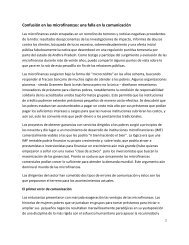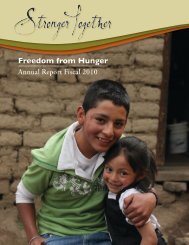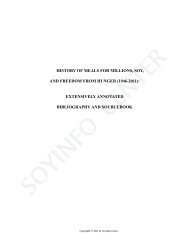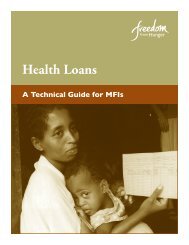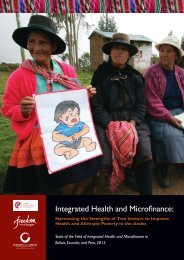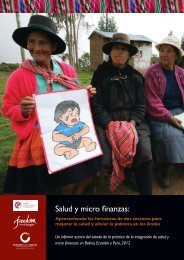Strengths, Weaknesses and Evolution of the Peace Corps' 11-Year ...
Strengths, Weaknesses and Evolution of the Peace Corps' 11-Year ...
Strengths, Weaknesses and Evolution of the Peace Corps' 11-Year ...
You also want an ePaper? Increase the reach of your titles
YUMPU automatically turns print PDFs into web optimized ePapers that Google loves.
community banks in Bahía charged <strong>and</strong> it is easy to calculate. Therefore, this amount has been easily<br />
replicated by o<strong>the</strong>r community banks in Bahía.<br />
Three community banks in Bahía charged 5% interest <strong>and</strong> ano<strong>the</strong>r three community banks had an<br />
interest rate that depended on <strong>the</strong> amount or length <strong>of</strong> <strong>the</strong> loan. For example, three different<br />
community banks described <strong>the</strong>ir interest rate as follows:<br />
5% interest per month for loans <strong>of</strong> $100 <strong>and</strong> 10% interest for loans <strong>of</strong> $50<br />
10% interest per month for a one-month loan. If you take a three-month loan, you only pay <strong>the</strong><br />
interest in <strong>the</strong> third month (e.g., for a $100 loan, you pay $<strong>11</strong>0 in month 3 <strong>and</strong> nothing in<br />
months 1 <strong>and</strong> 2)<br />
5% interest for a loan <strong>of</strong> three months <strong>and</strong> 10% interest for a loan length <strong>of</strong> four months or<br />
more<br />
Community banks that decreased <strong>the</strong> interest with larger loans or over a longer period said <strong>the</strong>y did<br />
so because <strong>the</strong>y are more difficult to repay. This benefit highlights how community banks are <strong>of</strong>ten<br />
socially oriented <strong>and</strong> <strong>of</strong>fer different saving <strong>and</strong> loan terms than commercial institutions do.<br />
When asked about <strong>the</strong>ir interest rate, members <strong>of</strong>ten gave a percentage amount. However, when<br />
asked how much money <strong>the</strong>y charged on a specific loan amount as an example, <strong>the</strong>y stated an<br />
amount that was not equal to <strong>the</strong> interest rate <strong>the</strong>y advertised. Therefore, <strong>the</strong> research team began<br />
asking for both <strong>the</strong> interest rate <strong>and</strong> an example to ensure accuracy. However, <strong>the</strong>re may be some<br />
inconsistencies in <strong>the</strong> data for <strong>the</strong> community banks where this was not done. This experience does<br />
reinforce <strong>the</strong> necessity to avoid using percentages for interest rates <strong>and</strong> instead stating interest more<br />
simply. For example, for 5% interest, <strong>the</strong> interest would be stated as $0.50 for every $10 borrowed.<br />
The 2002 Community Banking Evaluation found that 68% <strong>of</strong> community banks charged 10%<br />
interest, while 23% <strong>of</strong> community banks charged 5% <strong>and</strong> ano<strong>the</strong>r 9% charged a different rate.<br />
However, <strong>the</strong> interest rates are lower <strong>and</strong> vary much more among community banks in 2010,<br />
with 10% <strong>and</strong> 3% being most common <strong>and</strong> 5%, 2% <strong>and</strong> <strong>the</strong> interest depending on <strong>the</strong><br />
amount or length <strong>of</strong> loans being slightly less common.<br />
3.4.3 Loan Amount<br />
When asked <strong>the</strong> most common loan amounts in <strong>the</strong>ir community banks, most members in<br />
<strong>the</strong> Bahía sample cited $50, but <strong>the</strong>re was a range from $20–$300. Some community banks<br />
mentioned rare loan amounts <strong>of</strong> $500, $1,000 or $1,500. One community bank said that it only lends<br />
<strong>the</strong>se high amounts when <strong>the</strong>re are several family members <strong>of</strong> <strong>the</strong> borrower in <strong>the</strong> community bank<br />
who can help pay <strong>the</strong> debt if <strong>the</strong> member is unable.<br />
In <strong>the</strong> Loja sample, <strong>the</strong> average number <strong>of</strong> outst<strong>and</strong>ing loans per community bank was 12.9. The<br />
average amount <strong>of</strong> loans outst<strong>and</strong>ing was $3,422.90, which implies an average loan size <strong>of</strong> $265.34<br />
in Loja.<br />
The PAC methodology does not introduce a maximum savings amount.<br />
As indicated in Figure 5, <strong>the</strong> most common maximum loan amount was $100. This amount was<br />
more common in Bahía whereas <strong>the</strong> community banks in Loja had a lot <strong>of</strong> variation in maximum<br />
<strong>Strengths</strong>, <strong>Weaknesses</strong> <strong>and</strong> <strong>Evolution</strong> <strong>of</strong> <strong>the</strong> <strong>Peace</strong> Corps’ <strong>11</strong>-<strong>Year</strong>l-Old Savings Group Program in Ecuador P a g e | 13



